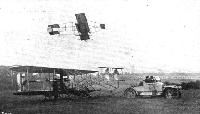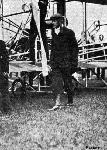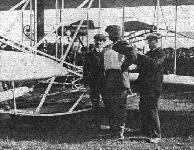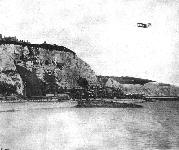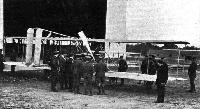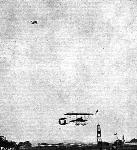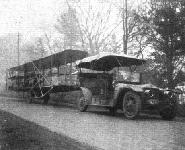
Описание
Страна: Великобритания
Год: 1909
C.Barnes Short Aircraft since 1900 (Putnam)
Short-Wright Biplanes
Wilbur Wright’s demonstrations of flying the improved Wright Model A biplane at Hunaudieres and Camp d’Auvours, near Le Mans, in August 1908, created unprecedented enthusiasm, with spectators and would-be passengers flocking from all over Europe to see him. After taking up numerous passengers in September and October, including leading members of the Aero Club of the United Kingdom, Wilbur Wright was bombarded with requests for replicas of the Flyer; Charles S. Rolls was among the first to place an unconditional order for one. But the demonstration Flyer was only the fourth powered machine the Wrights had constructed, and their contract with Lazare Weiller, promoter of their European tour, provided for his ultimate retention of it, after completion of an agreed programme of demonstrations, including tuition for not more than three pupils. It was the first of its particular type, and the Wrights had not intended to put it into production, so they had never made any complete working drawings. However, they agreed to allow copies of the Flyer to be built under licence by approved constructors, and in France these were to be Chantiers de France at Dunkerque and the Societe Astra at Billancourt; during his first visit to France in 1907, Wilbur Wright had arranged for a firm of precision engineers, Bariquand & Marre of Paris, to build spare Wright engines, and in 1908 he was so cordially welcomed at Le Mans by Leon Bollee, who put a bay of his well-equipped automobile factory at Wilbur’s disposal, that Bollee also was awarded a licence to make Wright engines. All sales in France were handled by Weiller’s firm, Cie. Generale de Navigation Aerienne, but all the British Empire rights were held by Griffith Brewer, who managed the Wrights’ U.K. patents.
Brewer was a well-known balloonist, and from his experience of the work of the Short brothers had no hesitation in recommending them as competent to manufacture the Flyer in England; by February 1909 Eustace Short had made a contract with Wilbur Wright to construct six aircraft at a total price of £8,400; all were already bespoken by members of the Aero Club, the first being reserved for Charles Rolls in accordance with his original order of the previous September. Rolls was impatient to begin learning to fly, and since Wilbur Wright declined to take on any more pupils in addition to the three (Comte Charles de Lambert, Paul Tissandier and Capt Lucas de Girardville) already nominated in France, he recommended Rolls to start practising with a glider of the type already described in the patent of 1906, and gave Short Brothers permission to construct one apart from the Flyer contract. On completion of his flights at Le Mans in December 1908, Wilbur Wright moved to Pau in the warmer south on 14 January, 1909, accompanied by Orville Wright and their sister Katharine, who had just arrived from the United States. Horace Short spent several days with Eustace at Pau in February measuring and sketching every aspect of the Flyer, and soon after his return to England he and his assistant, P. M. Jones, had produced the first complete set of working drawings ever made of any Wright biplane. Meanwhile, the Aero Club had established its new flying ground at Shellbeach on Sheppey, and half a mile away Short Brothers built a new factory in which to assemble the six Short-Wright Flyers; work on details began at Battersea, but the railway arches were too cramped for final erection of aeroplanes. The first building, a corrugated-iron shed 100 ft long by 45 ft wide, was put up by Harbrow of Bermondsey early in March 1909, and by May Horace was already lamenting its inadequacy and planning extensions; by August a second shed was in use and Short Brothers were employing 80 men. Horace Short designed and manufactured the Short-Wright glider at Battersea in four weeks during the spring of 1909, taking it to Shellbeach in June for fabric covering and final rigging; Rolls attempted his first launch, unsuccessfully, on 1 August and achieved his first glide the following day. Thereafter he practised regularly and with increasing proficiency till 10 October.
The Short-Wright glider had plain rectangular warping wings, with a forward biplane elevator and twin aft rudders exactly similar to the Wright glider of 1902-3, except that the pilot sat upright with a control lever in each hand; the left-hand lever moved fore-and-aft to control the elevator, and the right-hand lever moved sideways for warping and fore-and-aft to control the rudder. It was hand-launched from a trolley on a rail laid downhill on a slight eminence near Leysdown, and Rolls achieved soaring flights of several hundred yards in suitable weather. Rolls did not dispose of his glider until March 1910, when he offered it for sale in good condition, together with its shed and rail and the lease of the site.
The Wrights visited Battersea on 3 May and Shellbeach the next day, and were well pleased with the quality and progress of the six Flyers under construction. As at first built, they were exactly similar to Wilbur Wright’s demonstration Flyer, and only the last two ever incorporated later improvements. The two-spar wings had neither dihedral nor stagger and were wire-braced, with the two outer bays on each side arranged to warp. The main chassis comprised a pair of forward elevator outriggers combined with landing skids. An additional small feature, peculiar to Short-built Flyers, was a projecting wing-tip skid at each end of the lower leading edge, introduced by Horace Short because of frequent damage on the rough ground at Shellbeach. The biplane elevator incorporated an ingenious linkage for reversing the camber to match the angle of attack, so that when incidence was negative the camber was inverted. The parallel rudders were boxed together and pivoted on a central vertical axis carried by a single pair of upper and lower booms braced by wires to the rear spars. The pilot and passenger sat side-by-side on the left-hand half of the lower wing between the chassis frames, with the engine beside them on their right; they had separate seats with back-rests and a common fixed foot-rail. The pilot usually sat on the right, with a fore-and-aft elevator lever in his left hand and a universally pivoted lever in his right hand, which moved fore-and-aft to control the rudder and sideways to control the warp; thus the functions of ‘balancing’ and ‘steering’ were psychologically separated, while the use of rudder to counteract warping drag became instinctive with the right hand, leading naturally to the Wrights’ elegant banked turns, previously thought to be a highly dangerous manoeuvre in spite of its universal and age-old use by birds and bats!
The 27 hp four-cylinder water-cooled vertical engine of the Wrights’ own design drove, through separate chains in guide tubes and sprockets giving a reduction ratio of 9 : 32, a pair of two-bladed propellers mounted outboard just behind the wings with their thrust-line at half-gap; their tips rotated outwards at the top, so creating a resultant upwash in the middle of the slipstream, the longer left-hand chain being crossed to produce counter-rotation. The standard method of take-off was from a trolley on a launching rail laid to face into wind, with assistance from a rope hooked to the trolley and pulled by a falling weight previously raised on a portable derrick located downwind of the rail. This was a nuisance in variable wind conditions and a source of trouble whenever the rope jammed in a pulley, which happened rather often. Occasionally, in a steady light breeze, the Flyer could take off without external assistance, and later in 1909 some of those built in France appeared with wheels attached to the skids.
Although the first four Short-Wright Flyers were completed by July 1909, they were kept waiting for their engines, which had originally been ordered from Leon Bollee for all six; only two Bollee engines were finally delivered, and Bariquand & Marre were substituted in the others, but none was ready for Orville Wright to test personally in August as intended. As a temporary expedient, Frank McClean installed the engine out of his Nordenfelt car in his Short-Wright (No. 3) and was launched from the rail, but failed to sustain flight; two Bollee engines eventually arrived and early in October Charles Rolls made a few brief hops in his Short-Wright (No. 1), but came to grief; after repairs to the minor damage incurred, he began flying steadily on 1 November, and his proficiency was such that before the day was out he had covered 1 1/2 miles, thereby winning the first of four Aero Club prizes of £25 for a flight of 250 yards and the David Salomans Cup and £105 for a flight of half a mile out and half a mile back without landing. Three days later he won the first of three Aero Club prizes of £50 for flying one mile in a closed circuit at Shellbeach, which he accomplished at a height of 60 ft. Alec Ogilvie took delivery of Short-Wright No. 2 at his private flying ground at Camber Sands, near Rye, Sussex, on 3 November, 1909, when he flew for nine minutes. Next day he made two more flights of ten minutes each, but allowed enthusiasm to outrun caution; after attaining 50 mph (as shown by an air-speed indicator of his own design and later improved and patented by him) his Leon Bollee engine seized, but he made a safe forced landing. On 20 November Rolls flew from Shellbeach to the Aero Club’s new flying ground at Eastchurch, over an indirect course of 5 1/2 miles, but two days later he, too, suffered engine failure after covering seven miles. On the same day Frank McClean took delivery of the third Short-Wright, after installation of its Bariquand engine, making initial flights up to 400 yards in length, and continued to make steady if unspectacular progress whenever the weather permitted, attaining four miles by 17 December (the sixth anniversary of Orville Wright’s historic ‘first ever’ powered flight). McClean had not had as much prior experience as Rolls and Ogilvie, for the latter had purchased a Wright glider from T. W. K. Clarke of Willesden in August and had soared it for 350 yards after less than a fortnight’s practice. By 21 December Rolls had achieved a 15-mile cross-country flight over Sheppey and the fourth Short-Wright had been delivered to Maurice Egerton. On New Year’s Day 1910 Frank McClean flew from Eastchurch to Short Brothers’ works and back, and Rolls, after a solo flight of nearly an hour, took up Cecil Grace as his first passenger. During the next few weeks Rolls flew frequently with passengers, including Ogilvie, whose own machine was back at Shellbeach for repairs, and on 12 February Maurice Egerton flew over to Shellbeach to win both the third £25 and the second £50 Aero Club prizes.
The last two Short-Wright Flyers, ordered originally by Percy Grace and Ernest Pitman, incorporated an improved four-boom tail outrigger with a single fixed tailplane behind the rudders. Both were flown for the first time on 14 February, the former by Cecil Grace, who covered 300 yards (after earlier practice on Moore-Brabazon’s Voisin Bird of Passage) and the latter by Charles Rolls, who had bought it from Ernest Pitman before completion; after a spectacular high flight in his new machine on 25 February, Rolls towed his old Flyer behind his Silver Ghost tourer to London for exhibition on the Royal Aero Club’s stand at Olympia, after which he presented it to the Balloon Company, Royal Engineers, at Aldershot; subsequently he gave ground instruction to Army officers on it at Farnborough, and later it was kept at Hounslow Barracks, but there is no record of its ever being flown again. On 24 March Rolls collected his new Flyer from the works at Shellbeach and flew it thence all round Sheppey for 26 miles, attaining 1,000 ft over Queenborough before landing at Eastchurch. On the same day Cecil Grace won the remaining £25 and £50 prizes at Shellbeach; he went on to make regular flights throughout April, culminating in a 46-minute flight over Sheerness at 1,500 ft, in the course of which he dropped a packet of letters, all of which were posted by their finders and reached their destinations. Meanwhile Rolls had bought a new French-built Wright with a wheeled chassis, which he flew at the Nice International Meeting as one of the Royal Aero Club’s representatives; on his return he kept this machine for competition purposes, while his second Short-Wright was dismantled to donate its wings, elevators and empennage to his experimental Rolls Power Glider, or R.P.G., which also employed the wheeled chassis and 35 hp Green engine from the unsuccessful Short No. 3 biplane (q.v.). Consequently, he used his French Wright at the Wolverhampton meeting, having previously flown it on 2 June from Dover to Sangatte and back without landing, a feat which won him the Gold Medal of the Royal Aero Club and other awards. Ogilvie flew his Short-Wright (No. 2) at Wolverhampton, and a fortnight later he and Rolls both entered the same machines in the Bournemouth meeting, where Rolls met his death on 12 July while making a second attempt to win the alighting competition. Horace Short, who examined the wreckage, concluded that the tail-boom was not stiff enough to carry the controllable aft elevator which Rolls had fitted only five days earlier, and had deflected far enough to touch the tip of one propeller, with catastrophic results.
After Rolls’ death Short Brothers bought back Short-Wright No. 6 from his executors, reassembled it and sold it, less engine, to Alec Ogilvie, who had already fitted wheels to his first Flyer with some success. This encouraged him to make a series of modifications to No. 6, with a view to competing in all British events, including the de Forest prize and the British Michelin Cup, for which Bollee and Bariquand & Marre engines were ineligible. He first considered fitting a 50 hp E.N.V., but the British-built model of this engine was not yet available, so he chose a new 50 hp V-4 two-stroke supercharged N.E.C., which he installed in September 1910; then he went to New York as the Royal Aero Club’s entry in the Gordon Bennett Race at Belmont Park in October. His mount was a Wright C-type racer, with wheels but no front elevators, whose performance so impressed him that on his return to England in December he tried hard to persuade Horace Short to accept the Wrights’ offer to extend Shorts’ manufacturing licence to include the later models; Horace refused to do so, and Ogilvie thereupon went off, apparently in rather a huff, to Camber, where he proceeded to convert the sixth Short-Wright to the latest Dayton standard, with the tailplane turned into an aft elevator, the front elevators deleted, the skids shortened and the ‘blinkers’ placed low on them. He also incorporated Orville Wright’s improved steering control, comprising a fore-and-aft lever for the right hand, operating rudder and warp together, with a sideways-hinged handle at the top, whereby a limited amount of differential movement could be interposed between rudder and warp controls. The N.E.C. engine rotated the opposite way to the Wright, and with a rear elevator this was found to be an advantage because it gave pitch-up with engine on and pitch-down with engine off, so improving longitudinal stability and making the machine less tiring to fly.
With these modifications, Ogilvie flew 142 miles in just under four hours on 28 December, 1910, in an attempt to win the British Michelin Cup, terminated prematurely by a radiator leak. In May his lease of the Camber ground expired and he flew back to Eastchurch on 2 May, 1911, and remained there; in later months he modified his machine even more, bringing the engine forward and placing the pilot’s and passenger’s seats behind it, the whole being enclosed in a nacelle. This improved performance as well as comfort, and on 29 June, 1912, he took off at Eastchurch with three passengers in addition to his own not inconsiderable weight; still later he tried it on floats at Leysdown, but found it unseaworthy. Ogilvie’s modified Short-Wright was still being regularly flown right up to the outbreak of war in August 1914, and its N.E.C. engine survives in the Science Museum, South Kensington, London, together with the Wright-Bollee engine and one propeller from Short-Wright No. 2. One of the Bariquand & Marre engines, almost certainly that first installed in Short-Wright No. 6, was stored successively at Eastchurch and Rochester and was later restored and placed on permanent exhibition at Queen’s Island, Belfast; incidentally, Bariquand & Marre’s London agency, Barimar Ltd, became world-famous as exponents of machinery repairs by welding and now, based at Newcastle-upon-Tyne, occupies a leading place in shipbuilding and heavy steel fabrication.
Glider - Span 32 ft 10 in (10 m); length 18 ft (5-5 m); area 325 sq ft (30 m2).
Flyer - Span 41 ft (12-5 m); length 29 ft (8-8 m); area 515 sq ft (47-8 m2); empty weight 885 lb (401 kg); loaded weight 1,200 lb (545 kg); speed 50 mph (80 km/h).
Описание:
- C.Barnes Short Aircraft since 1900 (Putnam)
- M.Goodall, A.Tagg British Aircraft before the Great War (Schiffer)
- P.Lewis British Aircraft 1809-1914 (Putnam)
- Журнал Flight
Фотографии
-
M.Goodall, A.Tagg - British Aircraft before the Great War /Schiffer/
Short-Wright biplane S.5 was the third of these built for F.K. McLean.
-
C.Barnes - Short Aircraft since 1900 /Putnam/
Mr. Frank K. McClean, a member of the Committee of the Aero Club, on his Short-Wright biplane just leaving the starting rail during one of bis recent successful flights at Eastchurch, Isle of Sheppey.
Frank McClean being launched on Short-Wright No. 3 at Leysdown late in 1909. Short-Wright biplane S.5 was the third of these built for F.K. McLean. -
Журнал - Flight за 1909 г.
In England, six Wright Flyers were built under license by the Short brothers. Here, Mr. Francis Kennedy McClean takes off at Eastchurch, Isle of Sheppey, in his Short-Wright Model A late in 1909. A distinctive feature of the Short-built machines was the small skid protruding forward at each wingtip. In 1910 this machine was fitted with wheels and a fixed tailplane.
-
Журнал - Flight за 1910 г.
BRITISH FLYERS AT SHEPPEY. - Mr. Cecil S. Grace during one of his numerous flights on his Short-Wright machine at Eastchurch.
-
Журнал - Flight за 1910 г.
Mr. Stuart Ogilvie flying on his Short-Wright biplane over Camber Sands.
-
P.Lewis - British Aircraft 1809-1914 /Putnam/
Hon. C. S. Rolls making a cross-country flight from Shellbeach to Eastchurch on 21st December, 1909, with the first Short-Wright Biplane.
-
Журнал - Flight за 1910 г.
Mr. Claude Grahame-White, on his Henry Farman at Wolverhampton, flying over Mr. Ogilvie's Wright machine, which is being towed back to the starting place.
Другие самолёты на фотографии: Farman Farman-IV - Франция - 1910
-
M.Goodall, A.Tagg - British Aircraft before the Great War /Schiffer/
Short-Wright biplane S.6 acquired by Ogilvie after Rolls died. It was much altered by him at Camber Sands and was flown successfully until 1914.
-
Журнал - Flight за 1910 г.
The late Hon. C. S. Rolls after his first official flight on Monday last at the Bournemouth Meeting.
-
Журнал - Flight за 1910 г.
The Hon. C. S. Rolls has his lifebelt adjusted prior to his attempt to fly the Channel on his Wright machine.
-
Журнал - Flight за 1910 г.
The Hon. C. S. Rolls' Epoch-making Flight, on his Short-Wright type Biplane, across the Channel and back last week. - A "composite" photograph, giving a vivid impression of the flight as seen from the water.
-
Журнал - Flight за 1910 г.
As announced last week, the Hon. C. S. Rolls has been giving helpful instruction to the officers at Aldershot in connection with the Wright biplane which has now its home there with the Army. Our picture shows Mr. Rolls (with the cap and muffler) explaining the working of the machine. Mr. Mervyn O'Gorman is standing to his left.
-
Журнал - Flight за 1910 г.
The late Hon. C. S. Rolls, on his Wright flyer, starting for his trial in the Slow Competition at Bournemouth.
-
Журнал - Flight за 1910 г.
M. Christiaens on his Henry Farman during a long-distance flight, and above, the late Hon. C. S. Rolls going for the height prize on his Wright machine.
Другие самолёты на фотографии: Farman Farman-IV - Франция - 1910
-
Журнал - Flight за 1910 г.
Towing back Ogilvie's machine after he was driven down to earth by a sudden storm. Note engine, &c, protected with tarpaulin.
-
Журнал - Flight за 1910 г.
How the Hon. C. S. Rolls, with his 6-cyl. Rolls-Royce car, towed his Short-Wright flyer from Eastchurch to Olympia. The car and "trailer" on the road. When travelling during the night, lanterns were hung round the aeroplane, with some rather amusing results amongst the sleepy waggoners and other traffic met en route.
-
Журнал - Flight за 1911 г.
Mr. Alec Ogilvie making his flight of 140 miles in 3 hrs. 55 mins., for the British Michelin Cup on his British-built N.E.C.-engined Wright flyer, on Camber Sands last week.
-
C.Barnes - Short Aircraft since 1900 /Putnam/
Mr. Ogilvie's Wright biplane in flight, showing the "blinkers" in front.
Alec Ogilvie flying his modified Short-Wright No.6 at Camber in October 1910. -
Журнал - Flight за 1911 г.
Mr. Alec Ogilvie, on his N.E.C. engined Short-Wright machine, flying well over the Camber sands during his recent fine flight for the Michelin Cup.
-
Журнал - Flight за 1912 г.
Mr. Alec Ogilvie flying his N.E.C.-engined Wright biplane at the Royal Aero Club's Eastchurch grounds last week.
-
Журнал - Flight за 1911 г.
Another view of Mr. Alec Ogilvie rounding one of the mark rowers during his flight for the Michelin Cup on his N.E.C.-engined Short-Wright biplane.
-
Журнал - Flight за 1911 г.
Full warp on Mr. Ogilvie's Wright biplane. Note the position of the rudder. The combined movements are the result of a permanent interconnection between the two mechanisms, and are effected by simply pushing the control lever forward.
-
Журнал - Flight за 1911 г.
View showing the position of the rudder on Mr. Ogilvie's Wright biplane when the handle of the control lever is turned over as illustrated.
-
Журнал - Flight за 1911 г.
View of the warp and rudder-control lever on Mr. Ogilvie's Wright biplane. On the right is the elevator-lever controlling the tail, and by its side is the friction-brake that holds it in position.
-
C.Barnes - Short Aircraft since 1900 /Putnam/
Alec Ogilvie in his rebuilt Short-Wright with positions of pilot and engine revised and enclosed in a nacelle; Eastchurch 1913.
-
Журнал - Flight за 1909 г.
Interior of Short Brothers' principal erecting shop, where the British-built Wright flyers are in course of construction. Although hardly established three months in their new premises, Messrs. Short are already employing 80 men. The above shop is 140 ft. long by 45 ft. wide.
-
C.Barnes - Short Aircraft since 1900 /Putnam/
Cecil Grace on Short-Wright No. 5 at Leysdown, showing the revised double tail-boom.
-
Журнал - Flight за 1911 г.
Sketch illustrating the control of Mr. Ogilvie's Wright biplane,
-
C.Barnes - Short Aircraft since 1900 /Putnam/
Short-Wright biplane







